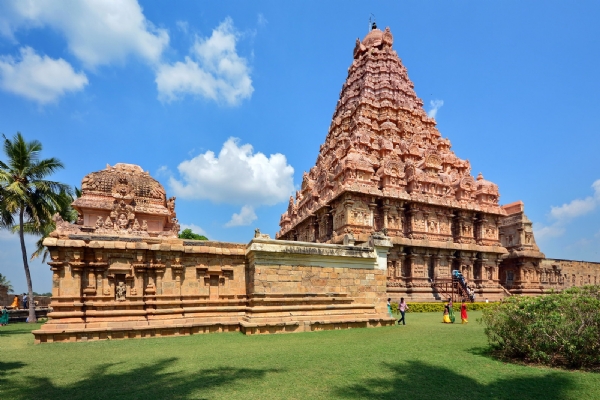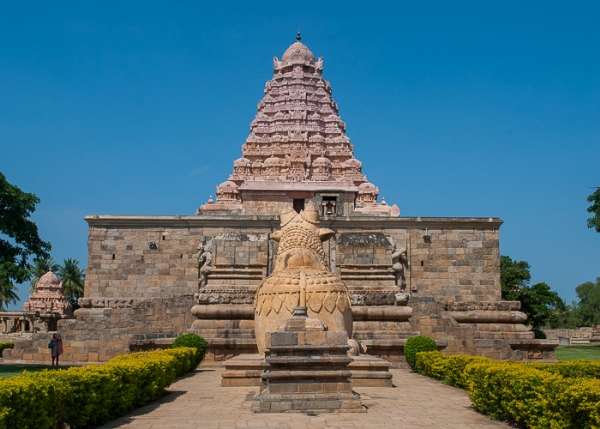Gangaikonda Cholapuram temple: The ancient pride of the Chola dynasty!
05 Feb 2022 17:40:41
Chola dynasty is well-known as one of the longest ruling dynasties in southern India. But how many of us know about the Gangaikonda Cholapura? This town and its history is vast and held a lot of importance once, but got lost over the centuries. The Gangaikonda Cholapuram is a small town located in Ariyalur, Tamil Nadu. It became the capital of the Chola dynasty in C. 1025 during the reign of Rajendra Chola I, and served as the Chola capital for around 250 years.

Architecture | Unfortunatel, the temple remains incomplete with its run-down walls, uncovered entrance to the temple, a roofless Nandi, etc. There are many huge disfigured stone figures in the open near the temple. It happened due to vandals and anti-social individual. But it is now well protected. The vimana in the temple is 55 m high and is modelled after Brihadeshwara temple at Thanjavur. The temple is a major attraction in Tamil Nadu and is also a UNESCO World Heritage Site. Also included in this list is Airavatesvara temple at Darasuram (near Kumbakonam temple city, Tamil Nadu) and they are referred to as Living Chola temples.

For the daily puja protocol here, four kaala pujas are held as per temple regulations. The major temple festivals that are celebrated with devotion and fanfare are the Shivarathri - (Tamil month of Masi February - March), Aipassi Pournami (October - November) and Thiruvadirai during Margazhi (December - January).

The great temple of Brihadeshwara Temple here, is next only to the Brihadeshwara temple at Thanjavur in its monumental feature, and surpasses it in sculptural style. The Brihadeshwara temple, is dedicated to lord Shiva, is a world-famous UNESCO recognized heritage Hindu temple made entirely of hard rocks, mostly granite stones.
History | Rajendra Chola I made Gangaikonda Cholapura the new capital of the Cholas. He conquered a large area in South India, Sri Lanka, Bangladesh, Sumatra, Kadaram, Cambodia, in the beginning of the 11th century A.D. He ruled vast areas in Southern Indi, from the Tungabhadra River in the north to Ceylon in the south. Gangaikonda Cholapuram remained the capital for 250 years from about 1025 AD. Unfortunately, once a famous capital is now a small, dusty town without sheen.
The actual temple, was built in 1020 during 6th regnal year. Rajendra Chola I built this temple to commemorate his
victory in the Ganges region over the Pala Dynasty. Hence, he assumed the name of Gangaikonda Cholan - meaning the one who conquered the Ganges.
Also Read | Mandore Gardens: the abandoned beauty of Jodhpur
Gangaikonda Choleeswaram dedicated to God Shiva was completed in 1035 AD and Rajendra Chola I used the Thanjavur Big temple as a model and emulated his dynamic father Rajaraja Cola I. It is also one of the largest Shiva temples in India built in impressive Dravidian architecture.
Architecture | Unfortunatel, the temple remains incomplete with its run-down walls, uncovered entrance to the temple, a roofless Nandi, etc. There are many huge disfigured stone figures in the open near the temple. It happened due to vandals and anti-social individual. But it is now well protected. The vimana in the temple is 55 m high and is modelled after Brihadeshwara temple at Thanjavur. The temple is a major attraction in Tamil Nadu and is also a UNESCO World Heritage Site. Also included in this list is Airavatesvara temple at Darasuram (near Kumbakonam temple city, Tamil Nadu) and they are referred to as Living Chola temples.

A western historian who had studied Gangaikonda Cholesvaram, compared the structural difference of this Srivimana with that of Rajaraja-I’s Brihadisvara temple at Thanjavur. He mentioned that this Srivimana is of feminine structure and the Tanjore Srivimana as masculine in nature. There seem to be 2 praharams surrounding the Srivimana, most of the wall is destructed and the granite rocks were used to construct the lower anicut during the British rule. The temple was located at the centre of the Gangaikonda Cholapuram city and occupies 6 acres of land. The main obvious difference is this Srivimana has an 8 sided / octagonal in structure and Thanjavur Srivimana has a 4 sided / quadrantal in structure.
Also Read | Hoysala temples: An umbrella of 100 creations by the Hoysala empire
The basement of Srivimana is 100 feet by 100 feet and the foundation is a square structure, and raises 20 feet above the ground level. One has to enjoy the beauty and the elegance and these fine masterpieces by visiting Gangaikonda Choleshwara. No number of words, or even photographs available can justify the beauty of this 1000-year-old art and architecture!
For the daily puja protocol here, four kaala pujas are held as per temple regulations. The major temple festivals that are celebrated with devotion and fanfare are the Shivarathri - (Tamil month of Masi February - March), Aipassi Pournami (October - November) and Thiruvadirai during Margazhi (December - January).